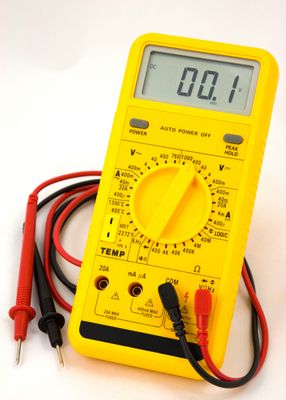Using a multimeter to test DC voltage, AC voltage, resistance, and current is crucial in various electrical and electronic tasks.
Measuring DC Voltage
Essential for checking batteries, power supplies in electronic circuits, and solar panels. Accurate DC voltage measurements ensure devices operate at safe and efficient levels.
How to measure DC voltage:
- Set your multimeter to the DC voltage mode (often denoted as 'V-' or 'DCV').
- Choose an appropriate range if the multimeter is not auto-ranging.
- Connect the black test lead to the 'COM' jack and the red test lead to the 'VΩmA' jack.
- Touch the red probe to the positive side of the component and the black probe to the negative side.
- Read the voltage on the display.
Measuring AC Voltage
Vital for household and industrial electrical systems. This test helps in diagnosing issues in home appliances, power tools, and HVAC systems, ensuring they receive the correct voltage.
How to measure AC voltage:
- Set your multimeter to the AC voltage mode (often denoted as 'V~' or 'ACV').
- Select the correct range if required.
- Connect the test leads as before, with black to 'COM' and red to 'VΩmA'.
- Place the probes across the component or power source.
- The display will show the AC voltage.
Measuring Resistance
Important for verifying the condition of components like resistors, fuses, and wires. It helps in identifying broken circuits and ensuring current flows as intended.
How to measure resistance:
- Turn the multimeter to the resistance mode (represented by the symbol 'Ω').
- If manual ranging, select the expected resistance range.
- Connect the test leads in the same manner as voltage testing.
- Place the multimeter probes across the component to measure resistance.
- The displayed value indicates the resistance in ohms.
Measuring Current
Crucial for testing the flow of electricity through a component or circuit. This test helps in ensuring devices are not drawing more current than they should, preventing potential damage.
- Set the multimeter to the current mode (denoted as 'A', 'mA', or 'μA').
- For large currents, use the '10A' jack; for smaller currents, use the 'VΩmA' jack.
- Open the circuit and connect the multimeter in series (so that the current flows through the multimeter).
- Read the current value from the display.
Always ensure the multimeter is set to the correct mode and range before testing to avoid damage to the multimeter or the circuit being tested. Moreover, always start with a higher range and reduce as necessary when testing voltage or current to prevent overloading the multimeter.
